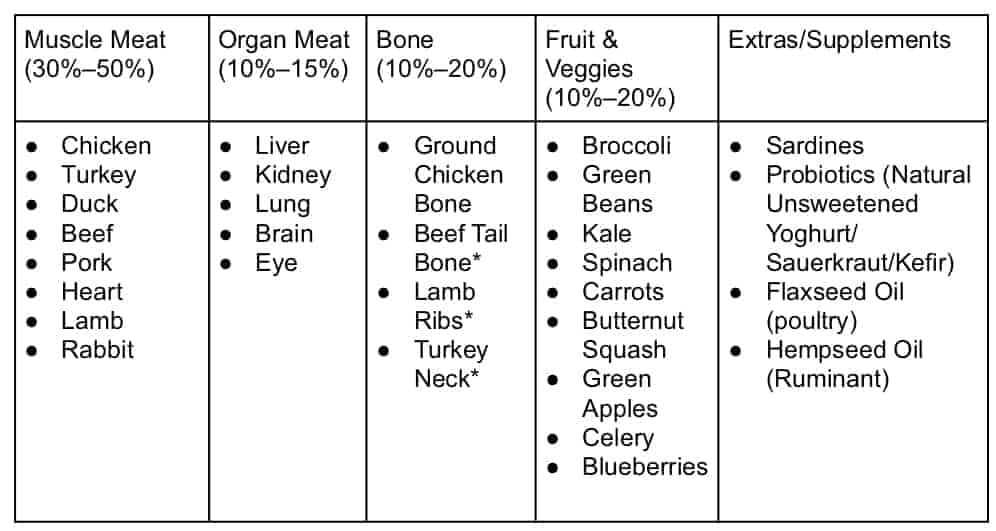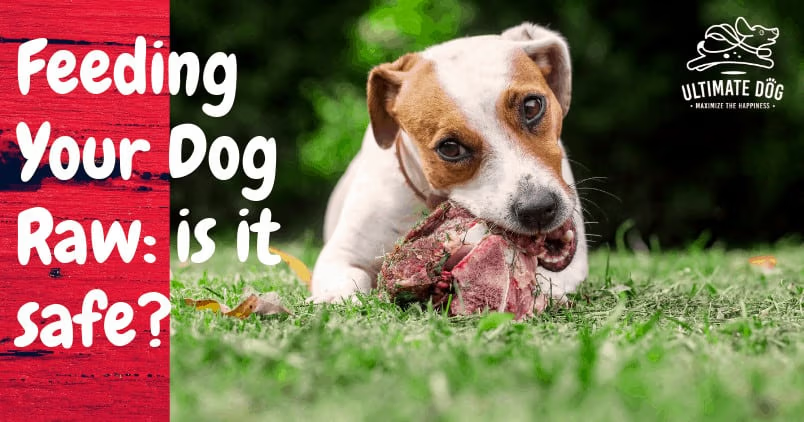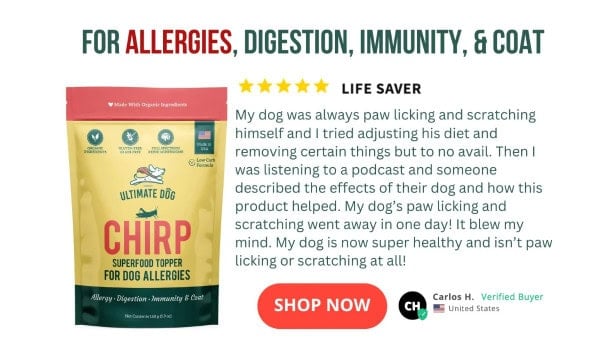We all want the best for our dogs, but the sad truth is, just like human junk foods, many commercially produced dog foods are highly-processed. They often contain poor quality ingredients, fillers, flavorings, preservatives, additives, and other chemicals which are potentially damaging to your dogs’ health over the course of their lifetime.
Commercial dog foods also often use grains to ‘bulk-out’ the food and provide an inexpensive source of energy. While this may seem to make sense in principle, the problem is that dogs are not able to easily digest carbohydrates such as grains. High levels of carbohydrates in the diet are widely believed to be a cause of allergies.
This can lead to dry, flaky and itchy skin, hair loss, rashes, ear infections, and frequent stomach upsets. Certainly not a recipe for a happy pooch!
Avoiding commercially produced dog foods and switching to a raw diet is the best way to take control of your dog’s health. Raw feeding has become increasingly popular in recent years and can be easily accomplished from the comfort of your kitchen.
Ready to start feeding raw? In this article, we’ll give you five easy raw dog food recipes and help you transition your pooch from junk food to nutritional nirvana!
What is Raw Food for Dogs?
In the simplest terms, a raw food diet gives your dog exactly what nature intended – the main components of a prey animal. This means a balanced combination of high-quality meat, bone, internal organs, fruit, and vegetables. It may sound odd to feed your dog vegetables, but wolves and other wild dogs will feed on the entire carcass of their prey. Therefore, it is perfectly natural for them to ingest vegetable matter found in the stomach and intestines of their kill.
If done correctly, a raw diet will provide all the nutrients, amino acids, enzymes, vitamins and minerals your dog needs to live a healthy and happy life – without any of the highly-processed, artificial or potentially damaging ingredients found in many commercial dog foods.
Not only does a raw diet help prevent allergies, but it also contributes to firmer stools, a shinier coat, better energy levels, and improved dental hygiene. Your dog is much more likely to enjoy his mealtimes, too!
Here are just some of the benefits you can look forward to after switching to feeding raw:
- Improvement or elimination of allergies
- Reduced skin dryness/itchiness
- Healthier weight and body composition
- Shiny coat
- Whiter teeth
- Reduced bad breath
- Better quality stools and less gas
- Increased energy levels
- Better joint mobility
- Stronger immune system
- General improvement in wellbeing
How to Make the Switch To Raw Dog Food
Now that you understand the benefits of a raw food diet for your dog, you’ll likely want to make the switch away from commercial food as soon as you can. However, before you dive in headfirst and serve your pooch a bowl of raw meat and bones, it is important to remember to take things slow, to begin with.
While some people advocate a ‘cold-turkey’ method of switching to a raw diet, this can cause stomach upsets for many dogs. After years of eating dried kibble or processed meat, a sudden change in diet may be difficult for your dog’s digestive system to manage. The PH levels of their stomach acids will have adjusted to the type of food they are used to eating – so a stomach-full of raw meat, organs, and bones may make them feel a little queasy!
To keep your pooch comfortable on the path to a better diet, a gradual transition is key. This doesn’t need to take long. In fact, it can often be accomplished in as little as a week.
Start by introducing small portions of raw meals separate from their usual processed food. As the days go by, you can slowly reduce the serving size of their processed food while increasing the size of their raw meals, until your dog is on a 100% raw diet.
It is better to start with bland foods, to begin with, such as meaty bones, chicken breast or minced beef and vegetable puree for the first couple of weeks. Once your dog is settled with a raw diet, you can then introduce richer organ meats for a perfectly balanced and delicious meal.
Don’t panic if your dog has some stool fluctuation during the transition stage. Mild constipation, diarrhea, or even occasional vomiting are completely normal as their body adjusts to their new diet.
Just keep an eye on their behavior and judge for yourself whether you need to slow down the process further. Eventually, any digestive hiccups will go away completely, and your dog can reap the full benefits of his new diet!
5 Homemade Raw Dog Food Recipes
Here at Ultimate Dog, we understand that taking the leap into raw feeding can feel a little overwhelming.
To help you on your journey, we’ve created five homemade raw dog food recipes for you to follow – so you can create delicious, nutritionally balanced meals for your dog without the stress!
These meals should be served fresh, but you can keep them in the fridge for a few hours beforehand if necessary. You can also batch freeze and thaw if you would rather pre-prepare them.
Lastly, don’t get too hung up on the percentages. Just try to keep them as close as possible for a balanced diet. Your dog will thank you!
1. Champions Chicken
30 – 50% chicken breast
15% – chicken livers
10% – 20% ground chicken bone
5% – 10% chicken eggs (raw)
5% – 10% broccoli (finely chopped/pureed)
5% – 10% carrots (finely chopped/pureed)
1 tablespoon natural yogurt (optional)
2. Meaty Medley
40% – 45% ground beef
15% – chicken heart and liver
10% – 20% beef tail bone
5% – 10% green beans (finely chopped/pureed)
5% – 10% broccoli (finely chopped/pureed)
1 tablespoon natural yogurt (optional)
3. Fishy Favorite
35% – 40% mackerel or other oily fish
12% – 15% bone-in turkey neck
10% – 30% chicken hearts and livers
5% – 10% spinach (finely chopped/pureed)
5% – 10% carrots (finely chopped/pureed)
1 tablespoon natural yogurt (optional)
4. Sheepish Supper
35% – 50% ground lamb
10% – 15% beef hearts and liver
12% – 20% ground chicken bone
5% – 10% butternut squash (finely chopped/pureed)
5% – 10% green beans (finely chopped/pureed)
5% – 20% spinach (finely chopped/pureed)
1 tablespoon natural yogurt (optional)
5. Porky Pooch
35% – 50% ground pork
10% – 15% beef hearts and kidney
12% – 20% ground chicken bone
5% – 10% broccoli (finely chopped/pureed)
5% – 10% green apple (finely chopped/pureed)
5% – 20% kale (finely chopped/pureed)
1 tablespoon natural yogurt (optional)
Don’t Forget The Right Fats!
Just like humans, dogs require essential fatty acids from their diet, as their bodies are not capable of creating them.
These fatty acids are necessary to maintain healthy eyes, proper muscle development, and support the internal organs. Adding some extra fats to your dog’s diet a few times a week is an easy and effective way to provide your dog with optimum nutrition.
Aside from adding a couple of sardines to your dog’s meal a few times a week, the simplest way to add healthy fats is by using oils. Hempseed and flaxseed oil are perfect choices. These oils are jam-packed with the fatty acids and have a light, nutty flavor which is inoffensive to dogs.
The type of oil that you add will depend on the protein source you are using.
Hempseed oil should be used when feeding beef or any other ruminant, while flaxseed oil should be used when feeding poultry. A serving of 1 tsp per pound of meat a couple of times per week is all that your dog needs to stay in top form.
The Importance of Varying The Protein Source
You may have noticed that our raw dog food recipes all have different main protein sources. This isn’t by accident!
When raw feeding your dog, you must be mindful to change up the primary source of protein regularly. This will ensure that your dog is getting the full spectrum of amino acids (the building blocks of protein) required for optimum health.
Furthermore, if their gut is exposed to the same type of food over and over again, much like with commercial foods, its ability to adapt is weakened. So, by feeding a variety of protein sources, you will also reduce the risk that your dog will develop food intolerances or allergies later in life.
How to Create Your Own Raw Dog Food Recipes
If you’re new to the world of raw feeding, our homemade raw dog food recipes are the perfect place to start. You can rotate these recipes throughout the week, safe in the knowledge that your pooch is getting all the nutrition he needs.
However, once you become more confident, you may wish to bring even more variety into your dogs’ meals. Understanding the key components of a raw diet and how to put them together will set both you and your dog up for a lifetime of healthy eating.
If you’d like to experiment with creating your own raw dog food recipes, the below table provides all the information you need to get started. Simply pick your ingredients, mix up the correct percentages, serve and wait for feedback from your pooch – mealtimes have never been this much fun!

*Note – If you’d like to give your dog raw meaty bones, these should be fed at 30%–50% of the overall meal. This is because the meat on the bone contributes to the muscle meat portion of the meal, yet the bone percentage remains the same. NEVER feed cooked bones to your dog.
How Much Raw Food Should You Give Your Dog?
The amount you feed depends on the age, weight, and activity level of your dog.
The ideal place to start is at around 1–3% of their body weight per day. Therefore, if you have a dog who weighs 45lbs, then you should feed between 7 – 22 ounces of food per day.
If your dog is very active, then you may need to feed them a bit more. Conversely, if your dog is pretty lazy, you can feed a little less. Nobody knows your dog better than you. Monitor their weight and energy levels over time until you find the perfect portion size.
What About Puppies?
Despite their size, these adorable little furballs need to eat a lot to support their growing bodies.
Puppies should be fed 2–3% of their future adult weight. So, if your pup will grow up to be a 45lb adult dog, they must eat between 14 –22 ounces per day.
Be mindful that puppy teeth are not as strong as adult teeth. Calcium is essential to their development, but stick to soft meaty bones or ground bone to avoid damaging their teeth at a young age.
Are There Any Risks Associated With Feeding Raw?
Feeding your dog a raw diet is as safe as any other kind of food preparation. So long as you take the correct precautions, there is no greater risk to you or your dog from switching to a raw feeding program.
Ideally, fresh meat and organs should be used in your raw dog food recipes. This reduces the likelihood of using any meat which is past its best. However, you should always check over meat and offal to make sure there’s no unusual odor, discoloration, or texture before feeding. To prevent food from going bad when stored, keep food refrigerated at below 40 °F or consistently below 0 °F when freezing.
Your dog’s digestive system can easily manage bacteria naturally present on raw meat. However, this is not the case for humans. When handling raw meat, always wash your hands thoroughly afterward and disinfect any surfaces or utensils used during preparation.
If you keep raw meat and offal in the fridge, be sure to place it in a deep, covered container on the bottom shelf – this is so that no meat juices can inadvertently drip onto other foods.
Lastly, NEVER feed cooked bones to your dog. Cooked bones become brittle and may shatter into sharp pieces, becoming lodged in your dog’s digestive tract or causing them to choke.
Conclusion
Feeding a raw diet is the best way to give your dog a long, happy, and healthy life.
Better still, as this article has shown, raw feeding doesn’t have to be complicated. By following our lovingly-created homemade raw dog food recipes or some simple guidelines, you can create tasty and nutritionally balanced meals for your pup with little effort.
Sources:
Fletcher, Danielle. “Raw Vs. Commercial Diets- The Facts”, https://www.viovet.co.uk, 22/10/2013
Rogers, Mike. “Preparing Raw Food For Dogs”, https://www.dogfoodinsider.com,12/12/2014
Mahaney, Patrick. “Raw Dog Food: How to Properly Store and Prepare”, https://www.petmd.com, 24/09/2012

Kelly Rowett is an animal lover and experienced full-time writer who’s passionate about creating high-quality content. When she’s not typing away at her laptop, you’ll find her hiking the coast path or playing endless seaside fetch with a pair of energetic Spaniels.




Leave a Comment